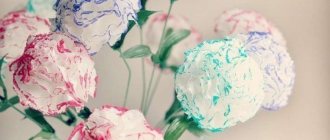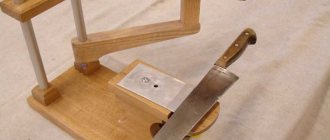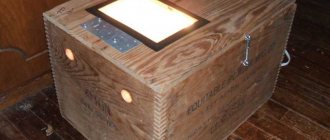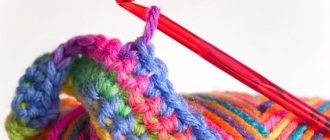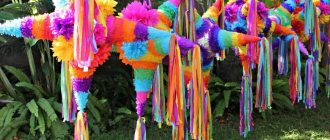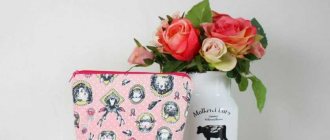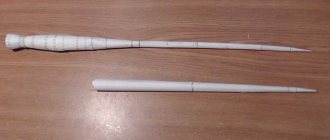Slipper models
There are several ways to sew slippers with your own hands. The sewing method depends on the chosen slipper model. They will definitely be on a sole, which is made of a tougher and more wear-resistant material. The sole is made of rough leather or leatherette, or even linoleum.
Children's UGG slippers are made with soft soles, for example, from thick suede material. Next, you need to decide on the design of the top part of the shoe. The top can be over the entire leg, then it will be closed slippers, or it can only reach the instep of the leg, then warm slippers will come out.
If you are going to sew slippers with your own hands, for the top you need to choose a fabric that will keep its shape. Ideally, also add an inner lining that will be in contact with the skin and will not irritate it like a rough outer fabric.
What to make home slippers from
Any fabric can be used to make slippers. The main thing is that it is warm.
For sewing soft house shoes, you can use the following materials:
| Product area | Materials |
| The basis |
|
| Sole |
|
| Insoles |
|
Another lining is often placed between the soles and insoles, for example:
- cardboard;
- foam;
- padding polyester.
To make a pattern, in addition to materials, you need to have the following tools and items on hand;
- thick paper or cardboard: patterns will be made from them;
- writing instruments; pencils, pens, markers, crayons;
- scissors: necessary for cutting paper and fabric;
- needles and threads: required for sewing;
- tailor's meter: it is necessary for the pattern, which is made based on the results obtained from the measurement.
Construction of a pattern
Before you start cutting fabric slippers with your own hands, you need to draw a pattern that you will apply to the fabric.
The easiest way to build a template yourself is to place your foot on cardboard or thick paper and trace the foot. Next, to make the flip-flops, you only need to outline half of the foot for the top of the shoe.
To make closed indoor slippers with your own hands, you need to put your foot sideways and outline it so that you get something similar to a child’s drawing of a boot. You can do otherwise and look for ready-made patterns on the Internet.
There will probably be more complex templates out there that you can print and use. In both cases, you need to leave allowances on all sides 5-10 cm wide so that the slippers do not end up being smaller after the seams are laid.
Instructions for sewing house slippers
House slippers (a life-size pattern makes it much easier to work with the product) are convenient to make, following a detailed description of each stage.
From felt
The process of making soft felt slippers takes place in the following stages:
- Prepare a template. You can place your foot on a piece of paper and outline your foot, or choose the desired size from the ready-made templates. Cut out parts from paper around the perimeter.
- Cut out parts from felt: 2 pcs. for the sole and 2 pcs. for the top. Also cut out a couple more sole parts from felt of a different color.
- Fold the resulting parts: from below - the sole element with the marks up, then the sole element of a different color with the marks up, on top of the upper element with the mark up.
- Connect the top marks with one stitch, and then tie the ends of the thread into a knot. Connect the parts on the left and right in the same way.
- Add some tacks. This whole procedure is repeated with the 2nd slipper.
- Proceed directly to sewing. Thread the thread through the eye of the needle, make a knot, and hide it between the layers of felt. Before starting the seam, make a fastening of 2-3 stitches in one place.
- Sew the pieces together with the seam facing forward. You should retreat approximately 10 mm from the edge. As you approach the locking stitches, cut and pull out the threads. At the end of the seam, make the same fastening as at the beginning.
- Using a thread of a different color, sew the bottom of the shoe, connecting the layers of the sole. All this is done again to make the 2nd slipper.
From a terry towel
Slippers made from terry fabric will be comfortable, soft, convenient and beautiful.
The stages of their creation will be as follows:
| Stage | Description |
| Make patterns | To do this, place your foot on the material and trace it, or take old slippers and attach them to the fabric. This will determine the correct size. A total of 6 elements must be cut out:
It is best to make both the top and the lining from terry cloth. This will make the shoes soft and cozy. In addition, the sewing process itself in this case will be quite simple. |
| Work with the inner layer | For the inner layer, you can use foam rubber or other insulating material. Another layer is laid under the heel, and then it needs to be secured with a stitch. Those who intend to use a sewing machine should remember that it does not go well on foam rubber. To make the screed easier, you need to put a mesh on the material. Foam rubber is also placed in the upper part of the slippers. |
| Connect the top to the lining | The soles can be taken from old slippers. It is better to make shoes a little larger than your foot size. Then it will turn out cozy, and it will be easier to dress. |
| Assemble elements into a single structure | You can use a sewing machine (a needle with a No. 120 is best). When sewing, you must be careful: when passing through the thickest areas, the speed should be reduced. |
| Perform facing | From terry cloth you need to cut a strip 4 cm wide and a length equal to the diameter of the sole. This will create a facing for finishing the edge of the shoe. The facing should be ground from the sole side. |
From an old sheepskin coat
If you have an old sheepskin coat in your closet that no one has worn for a long time, then instead of throwing it away, you can make comfortable slippers out of it. The front of the shoe is best cut from the sleeves. For soles, the part of outerwear that has no seams is most suitable.
When sewing such slippers, you must adhere to the following steps:
- Make a template on thick paper, and then transfer the drawing to the base material. This is done this way because the leather is thick and it will be difficult to fix the pattern on it.
- Cut out the pieces using large, sharp scissors. If the master decides to use small scissors, he will not succeed, because the tool will not cope with thick material.
- Place the cut paper pattern on the fabric and attach it to it with needles. This will make it easier to trace the pattern. It is best to use chalk for outlining.
- To process the edges of the product, take an awl. It is better to use a sewing tool that has a special small hole for threading. As soon as the material is pierced and the point comes out, thread the thread through the eye.
- Use an awl to make another hole in the material. It should be next to the previous one. The tip of the awl is also brought out, and the thread that was brought out earlier is threaded into its eye. It is pulled onto the second side of this leather part.
- Turn the part over and perform the same manipulations on the other side.
- Start stitching the tops and flaps. To make a lapel, you need to attach the shaft to the top of the sneaker. The 2 halves are joined with the seam facing inward. If the material of the sheepskin coat is not very thick, then a large needle is used. If the fabric has a high density, then it is better to work with a sewing awl.
- To make a durable sole, combine several layers of different materials at once. The upper part, called the insole, is made of cotton fabric or sheepskin fur. The middle layer is best made of padding polyester or foam rubber. You can use thick paper or felt. Leather, rubber and raincoat work well for the bottom of the sole. It can be difficult to connect all these layers. Strong threads and a sewing awl will come to the rescue here.
- When the sole of the slippers is made, connect it to the upper part. The seam from the connection can be left outside, or hidden inside. In the first case, it is recommended to use threads of a contrasting color. This will make your shoes beautiful and bright. As an addition, you can use accessories.
- When all the parts are sewn, turn the boot with the fur facing out.
From a blanket
The process of sewing slippers from plaid goes through the following stages:
- Make a pattern for the bottom of one sneaker. To do this, take a sheet of thick paper. Place your foot on it and trace it with a pencil or pen. In this example, the length is considered to be 24 cm. In addition, make indents for the seams - 5 mm along the entire diameter of the drawing. The result will be a pattern 25 cm long.
- Make a pattern for the top part. To do this, draw a rectangle on another sheet of paper, the length of which should be the same as the diameter of the drawing made at the previous stage. The width of this rectangle should be equal to the widest part of the foot. In this example, the widest part of the foot is 10 cm.
- Continue working on the pattern for the top. Place 10 cm down from one end to form a square. Afterwards, draw an arc line that should cover the toe. The height of the heel is 8 cm. Having measured it, you need to draw a parallel line, trying to round it near the square.
- Cut out the made pattern. The main thing in this matter is accuracy and strict adherence to the drawings.
- Fold the fabric in half, attach the pattern to it, take scissors and cut out the blanks.
- Once the pieces are cut out, sew the top together using a simple overlock stitch.
- Sweep both parts of the slippers, and then connect the parts again along the perimeter with the same seam.
- Pull out the running stitch.
Fur slides
House slippers (life-size patterns can be made from various materials) made from fur will require the presence of fur fabric in the required quantity. This simple but very warm shoe consists of 2 elements, so it usually takes about 2 hours or less to make. It all depends on the person's skill level.
The process consists of the following steps:
- Place your foot on thick paper and trace around your foot with a pencil or pen.
- To the drawing that results from tracing, add 2-4 cm from both ends.
- Apply the sheet to the top of the foot so that it extends from the toes to the instep.
- At the point of contact with the floor, trace the newly attached piece of paper with a writing instrument.
- Add another 2-4 cm to the resulting pattern.
- Cut out the blanks and create copies of them so that each of the 2 slippers has its own patterns.
- Once the pattern is made, place the resulting drawings on the prepared fur fabric, trace them, and then carefully cut out the parts. Considering that each part consists of an inner and an outer part, to sew a slipper you will need 4 blanks - 2 for the sole and 2 for the top.
- Combine the elements obtained in the previous stages. First of all, the lower and upper parts are secured with pins. Then the joint is stitched and the edge is finished.
If the slippers do not warm your feet very well, you can insulate them by making a batting insert in the sole. It is worth keeping in mind that it is better to cut this insert so that it is 2 mm smaller around the entire perimeter. In this case, it will be possible to hide it well, and the shoes themselves will turn out beautiful and neat.
It is recommended to make the outer part of the slippers from synthetics or genuine leather. This will increase the service life of the products.
Cutting a life-size pattern is a simple task that even beginners can do. And home slippers made on their basis both look beautiful and warm the feet in the cold season. Most of all, these shoes will appeal to young children, who are sometimes difficult to get to walk around the house in slippers.
Uncover the soles
It is best to make a sole of several layers. In this case, it will be similar to the factory sole, will last longer and will not allow your feet to freeze from the cold floor.
In order to get your own slippers with soles, cut out patterns for the right and left feet from the following components:
- Lining material
- Cardboard
- Foam rubber
- Linoleum
Cutting the top
The upper part can be cut from one layer or doubled, it all depends on how pleasant the material used is to the body. If you decide to sew shoes from fur fabric, felt or an old sheepskin coat, such fabric does not need a lining layer.
Future slippers made of fabric or felt are drawn along the pattern on the wrong side. In the case of fur fabric, you will have to draw from the front side. If you plan to use double-sided fur, then the template for the upper part of the slippers must be pinned directly to the fur with sewing pins.
Then all that remains is to cut out the pattern of the future product.
Sew the product
Next, you need to decide whether to sew the slippers yourself or use a sewing machine. If the thickness of the fabric or even fur is such that your sewing machine can sew it, feel free to sew the parts from the inside out. Thick fabric, fur and felt will have to be sewn by hand.
Note!
- DIY satin ribbon bows: photos of original design ideas, step-by-step DIY master class
- DIY hair bands - ideas for decorating homemade rubber bands + step-by-step instructions for making them yourself
- DIY shadow theater: step by step how to do it at home! 175 real photos
The most useful slippers
Felt indoor shoes made from felted camel, sheep or dog wool are considered the most useful because they are natural.
By creating a thermal effect, felt heals feet from rheumatic pain, aching bones, and protects against excessive sweating. Slippers on bare feet produce a gentle massage of the foot, dispersing blood throughout the body, which is especially useful for children and the elderly.
Recently, this material has been undeservedly forgotten, but tired of synthetics, people again turned their attention to fashionable felt that brings health.
Many factories have mastered the production of natural felt shoes, which are in great demand. But in the modern world they have begun to value what they created with their own hands without the use of modern machines and tools. Products are decorated with embroidery, applique, beads, beads, and braid. Mongolian slippers look very attractive .
But the main value of this product is felt. If the products are made from material with the addition of synthetics, then they will not provide true pleasure.
Sew the top
After the sole is sewn and ready, you need to attach the upper parts to it. You can sew them in the same way as the sole. You can apply a simple seam or “over the top”, basting.
As a result, the threads will be in a visible place, so it is better to choose them in a color that will be in harmony with the product. You can take threads in the color of the material or vice versa in a contrasting shade.
Pattern of slippers with a backdrop
Products with backs are constructed in the same way as flip-flops, but you still need to add a back piece. The pattern of this part can be made in a similar way, by attaching a piece of paper to the leg, and outline it, taking into account the height of the backdrop.
It's easy to make a pattern of the part by taking measurements. To do this you need to measure your foot:
- attach the beginning of the meter to the inside of the foot at the very bottom to the place where the upper part of the slipper will go;
- grab the back of your foot with a meter;
- fix the length on the outside of the foot, where the top of the product passes.
The height of the backdrop should be no more than 7 cm, then the slippers will be comfortable. Using the obtained dimensions, you need to draw the part on cardboard, not forgetting to add extra seams. The resulting pattern is applied to the material, the details are outlined and cut out. The upper parts are sewn together first and then attached to the sole. For one slipper with a back, 6 parts are cut out (with insulation for the sole there will be 7 of them).
Features of working with sheepskin coats
If you decide to sew sheepskin slippers with your own hands, the patterns should be sewn together only using the special tools mentioned above. The sole of such slippers can be made exclusively from the main fabric or attached to linoleum. All parts are sewn with fur inside.
From an old sheepskin coat you can make various models of indoor slippers, but the most comfortable indoor shoes made from such fabric are made in the form of boots. These indoor “ugg boots” can be made for adults, but most of all they will delight children.
Shearling boots will be pleasant when touching the delicate baby skin and will protect little feet from the cold.
Note!
DIY bracelets | Selection of the best models and master class on making beautiful braceletsDIY bird feeder - interesting ideas on how to make it quickly and easily from scrap materials
- Do-it-yourself cold porcelain: the best options for porcelain products, step-by-step instructions and recipes for making it yourself (photo + video)
Material selection
The way you feel when wearing shoes is largely influenced by the material from which they are made. In addition to the convenience and presentation of products, it is necessary to take into account such criteria as hygiene, thermal conductivity and strength.
In order to sew warm house slippers with your own hands, you can use the following blanks:
- An old sheepskin coat or sheepskin coat. Sheepskin has high thermal insulation properties, softness and stretchability. It is better to make slippers from a sheepskin coat from sleeves or floors, since the back and chest parts can later be used to make a vest.
- Tops of winter leather boots. Natural material has high strength and wear resistance. The downside is that it has too thin a layer of fur, which is not enough to provide reliable protection from the cold.
- Artificial fur. Synthetic products look good, are not afraid of dampness, and can be machine washed without problems. It’s not difficult to sew slippers, but the prospects for such work are questionable - synthetics do not absorb moisture and cause a lot of steam on your feet. There is a high probability of developing fungus and allergic reactions.
After choosing the material, you need to decide on the model of slippers. Depending on individual preferences, the pair of shoes produced may have an open or closed toe, heel counter or cuff.
Old sheepskin coat Faux fur Tops of old winter boots
This is interesting: Pattern of ballet slippers for children
Felt slippers
Above was described a method for creating slippers from finished felt, which is used as fabric. As it turned out, sewing slippers with your own hands is quick and easy, and the pattern is easy to create even for novice needlewomen. However, those craftswomen who master the skill of dry or wet felting can make a product using this technique.
Whatever method you choose, felt slippers will be warm and cozy in any case. You can decorate them with ribbons or a pattern. An ornament or a funny picture can be made using the felting technique or embroidered; you can also sew on a ready-made factory themed patch.
Felt is easy to sew and wears well, for a long time. This sets slippers made from this material apart from other house shoes.
How to sew boots
Now we will figure out how to sew boots with your own hands if you are doing this for the first time. Your kit should include:
- scissors
- needle and thread
- any high-quality and fresh glue suitable for fabrics
- soap and cloth
Make a pattern according to the above rules. Take this extremely seriously, because then the shoes may be too small and uncomfortable for you.
Then you need to make the bases of the slippers, the top and the sole. Fold in half and sew a seam. Then we sew the base of the boots with the insole.
If you are making slippers from fleece, sew padding polyester to the base. When your boots are almost ready, you can start decorating them.
Decoration of finished products
We figured out how to make slippers with our own hands, now it’s worth thinking about the decor. Of course, you can always make the product in a minimalist style and not decorate them in any way.
For some types of slippers, for example fur ones, this option is quite suitable; they already look attractive. Also, don’t over-decorate men’s shoes. Slippers for lovely ladies and especially for children can and should be further decorated.
Ladies' slippers can be decorated with flowers, ribbons, lace, and beads. In decorating, craftswomen can use any techniques they know.
The decoration can be crocheted or knitted, felted, embroidered with ribbons, satin stitch or cross stitch. Having figured out how to sew slippers with your own hands, you can give free rein to your imagination.
Decoration for kids
For children, you can even make slippers in the shape of funny animals. To do this, you can attach an animal’s head or a car to ready-made slippers. To do this, a soft toy is made from the same material as the house shoes themselves, which is filled with padding polyester or other filling for soft toys.
It will also be interesting to make slippers in patchwork style. Slippers made from different bright details will look funny and will probably please your child more than plain gray or brown ones. The parts can be made into square, triangular or hexagonal shapes.
In the latter case, the product will look like a honeycomb (an excellent reason to make “honey” slippers and attach soft bees on top) and sew them with a seam “through the top”.
We sew elegant slippers in 30 minutes
Today’s master class is special for me, I’ve been working on it for a long time. Before I managed to come up with and work out the correct and successful technology for making these slippers, I spent a lot of felt, fabric, transfers, various trial materials for the soles, and most importantly, working hours.
Before I managed to come up with and work out the correct and successful technology for making these slippers, I spent a lot of felt, fabric, transfers, various trial materials for the soles, and most importantly, working hours. In general, it may, of course, be due to my lack of intelligence, but today I am finally ready to present to the readers the result of all my torment - a quick, simple and budget-friendly way to sew original, bright, comfortable, and most importantly, quite durable and wearable homemade tapuli
In general, it may, of course, be due to my lack of intelligence, but today I am finally ready to present to the readers the result of all my torment - a quick, simple and budget-friendly way to sew original, bright, comfortable, and most importantly, quite durable and wearable homemade tapuli
In order to sew them, I prepared a special pattern for printing on a thermal transfer. Its use greatly simplifies and speeds up the process and reduces to almost zero all possible difficulties and errors when cutting parts.
In addition to the pattern, you will need light felt for transferring the transfer, any suitable (I only had white today) felt for the insole and, my main inspiration for this week, a cork sheet. In this case, 3 mm thick. Well, glue, I liked using “Moment Crystal” the most.
First of all, let's transfer the pattern to felt. Due to the fact that recently I have been asked more questions about translation technology, I will allow myself to say a little more about it today.
To begin, we will need to place the pattern right side into the felt and heat the iron to almost maximum temperature. Using a hot iron, we begin to carefully iron the sheet, not missing the edges or corners.
In my opinion, it is better to overheat the iron somewhat and, while ironing, notice that the felt has begun to melt (this is not an instantaneous process and you will always have time to slightly reduce the heat, nothing bad will happen), than to iron everything with a cold iron and get a fragmentary translated image, the more thereby ruining both the pattern and the felt.
We stroke the entire structure for about a minute, then cool it to a slightly warm state and remove the top checkered layer of paper. The picture has been translated.
Cut out the details of the slippers without seam allowances.
Since I made the pattern as universal as possible, I adhered to the principle “more is better than less.” Therefore, at this stage of work, I recommend trying it on at least approximately and if it turns out to be larger than necessary, trim the sides, as shown in the photo. As a rule, there is no need to reduce the size of the top and bottom, only if these are slippers for a baby.
Place the patterns for both slippers on a sheet of felt. You don’t have to take white anymore, you can use any color.
And we attach the parts with a semicircular seam. Only along the top edge.
Now we cut out the details along the contour, getting a double top for future slippers.
Now we need a pattern for the insole. It's very easy to get. It is enough to simply trace your foot on a piece of paper with a decent margin, or simply take any ready-made slippers that you consider the most comfortable and trace the sole with them.
We only outline the insole, but do not cut it out. I found it more convenient to sew in this order.
Now we baste the double top of the slipper. We baste in two approaches, starting each of them from the middle of the sock.
It will be very easy to stitch the top using sour cream. After machine stitching, you can pull out the basting thread.
Now the slippers with the insole can be cut out, retreating 2-3 mm from the edge of the stitching. We do the same with the second slipper.
Now it's time to begin the final stage. We will make the soles for slippers. After various searches for suitable material, I settled on cork. As practice has shown, this is a fairly easy-to-use material, very light. It is very practical to wear, especially in the glued version. Cork has good shock-absorbing properties and even a thin layer is sufficient to make the slippers comfortable to use.
Take the glue and properly lubricate the bottom surface of the felt insole. The glue, among other things, perfectly stabilizes the cork, reducing its fragility and preventing the possibility of cracks appearing when bent in the future.
Glue the insole to the cork sheet. We cut it out quite roughly, just to be able to install the clips.
The cork glues well and quickly, after the glue has firmly set, you can remove the clips and cut out the slippers along the contour of the insole.
You can stop at this stage of work or additionally sew the perimeter of the slipper on a sewing machine. The cork is very easy to sew, despite its thickness.
That's all, the slippers are ready. In the next photo I tried to demonstrate that cork glued to felt is quite strong when bending.
The slippers turned out like this:
How to knit indoor slippers
If suddenly you don’t have a craving for sewing or don’t have the necessary materials at hand, you can always knit indoor slippers with your own hands. To do this, you don’t even need to make a pattern of fabric slippers with your own hands.
Knitted slippers can be crocheted or knitted. Depending on the level of the craftswoman, slippers can be extremely simple or complex, openwork with beautiful decor. Knitted slippers can be ordinary closed ones, in the form of slippers or boots, it all depends on the desire of the master.
The sole of such shoes can be made simply of yarn or reinforced with dense material, as described above.
Also, an excellent economical option would be to use ready-made soles from indoor slippers, the tops of which have already worn out and become unusable. Then the upper part is sewn to the finished sole, which is knitted from yarn. You can also decorate knitted slippers with your own hands at your own discretion.
Products with felt soles
If you have a felt sole, knit the upper part with knitting needles so that you get soft slippers.
Owners of their own sauna or steam bath always receive many guests. To provide all your guests with similar shoes, sew a whole series of felt slippers. Even the largest stack will take up some space.
By the way, bath slippers will prevent your soles from getting burned on the hot floor.
If you have grandparents, sew them slippers that look like short felt boots, the gratitude will never end.
Caring for these shoes is very simple:
- The flip-flops can be washed and dried, after which they will not change their shape.
- High boots are dried using a shoe dryer or on a heating radiator.
Startup idea
As it turned out, all you need to do is arm yourself with the tools and write in the search bar of your browser: “make slippers with your own hands patterns”, download slipper patterns and you can start creating
But what to do if your hands are just drawn to work, and the whole family and relatives are already walking in your beautiful slippers? That's right, then they need to be sewn for sale.
In general, making thematically decorated house slippers, and even handmade ones, can be the start of a small business. Almost everyone will like such a gift.
A great idea would be to offer customers entire sets of gift slippers, for example tank-shaped slippers for work colleagues or slippers with decorative flowers for teachers for March 8th.
Sets of guest slippers will sell well, which will come in handy when many family and friends gather in one house for a holiday. The number of ideas on how to present customers with beautiful and warm handmade slippers is simply endless.
Slipper decor
I wanted to decorate the slippers additionally; after all, they will be entered into a competition.
Choosing the right decoration for a colorful surface is not easy. After going through many options, I settled on bows left over from an old bag.
Carefully trimmed the protruding edges.
I chose the place where I would attach them and made holes with an awl. I inserted the legs of the bows into them, folded them on the wrong side and pressed them tightly.
I bring to your attention the resulting soft home slippers - slippers, which I made with my own hands.
Zhenya, thank you for your participation in the competition and the very beautiful slippers, we just needed non-knitted ones, and also special thanks for the great work on creating the master class! And these slippers are perfect for guests, when someone comes home, there is always a problem of what to give them shoes, and they will be an excellent gift for the New Year and any other holiday.
- How to simply sew a beautiful oven mitt in the shape of a heart
- How to sew a robe without a pattern
- Coziness from pompoms. How to make pompoms from yarn. Pom pom crafts
- What to make from old T-shirts with your own hands
Administrator of the blog “The comfort and warmth of my home” Olga Smirnova
